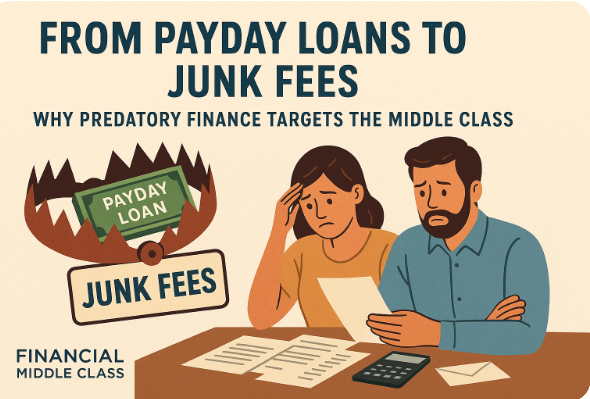If you’ve ever paid a $35 overdraft fee or borrowed $500 from a payday lender, you’ve felt the reach of America’s quietest predator — the financial system itself.
Predatory finance doesn’t always wear a mask.
Sometimes it hides behind glossy apps, “instant cash” promises, or “zero interest” offers that quietly reset your financial progress every month.
And lately, it’s the American middle class that’s become the primary target — not because they’re poor, but because they’re stretched.
Let’s unpack how the system evolved, why it preys on everyday households, and what you can do to stay one step ahead.
What Predatory Finance Really Means
Predatory finance isn’t one single company or product.
It’s a network of fees, traps, and short-term loans designed to exploit everyday financial pain points — usually when people are desperate, distracted, or in debt.
It includes:
- Payday loans with 400%+ APRs
- Overdraft and NSF fees from big banks
- Rent-to-own stores and “no credit check” furniture outlets
- Buy Now, Pay Later (BNPL) schemes that fragment your debt
- Advance apps that charge “tips” acting like disguised interest
It’s not the single transaction that hurts — it’s the pattern.
Why the Middle Class Became the Target
Once upon a time, these traps mostly targeted the unbanked.
But the middle class is now caught in the middle — not rich enough for private banking, not poor enough for free assistance programs.
1. Rising Costs, Stagnant Wages
Between housing, healthcare, and child care, middle-class Americans are facing costs that grow faster than their income.
That $5,000 emergency fund everyone says you need? For many, it’s a fantasy.
So they borrow small — and get charged big.
2. Financial Illiteracy Is Profitable
Banks and lenders thrive on confusion.
They make the process complex on purpose — because every misunderstanding becomes revenue.
As a result, the average household loses $1,000+ a year in unnecessary interest, fees, and penalties.
3. Convenience Culture
Instant everything — instant loans, instant approvals, instant deposits.
But convenience without caution is costly.
That “advance” app that gives you $100 until payday may be charging an implied APR of over 100% once you factor in the “optional” tip and processing fee.
Payday Loans: The Original Trap
Let’s start with the most infamous offender.
A payday loan is a short-term loan, usually $300–$500, due on your next paycheck.
Sounds harmless — until you realize the average borrower pays $520 in fees just to borrow $375.
That’s because payday lenders often “roll over” loans when borrowers can’t pay on time, creating a debt treadmill that can last months.
Example:
You borrow $400 to cover rent. Two weeks later, you owe $460. You can’t pay it all, so you roll it over — now you owe $520. Within two months, you’ve paid $240 in fees but still owe the original $400.
That’s how $400 becomes $640 — without ever missing a payment.
How Junk Fees Sneak In Everywhere
The modern bank is a masterclass in creative monetization.
They’ve built a business model around your mistakes — or what they define as one.
Here are some examples:
- Overdraft fees — $35 each time your balance dips negative
- Non-sufficient funds (NSF) fees — charged even if the transaction fails
- Early account closure fees — for leaving too soon
- Paper statement fees — for not going digital fast enough
- Inactivity fees — for not spending often enough
It’s death by a thousand small cuts — and it adds up to billions in profit.
New Traps: Buy Now, Pay Later (BNPL)
If payday loans were the old-school predator, Buy Now, Pay Later is the new-school one in disguise.
Companies like Affirm, Klarna, and Afterpay offer interest-free installments on everything from sneakers to sofas.
The problem?
BNPL encourages spending beyond your means.
People stack multiple plans, lose track of payments, and end up owing more than they planned.
In 2024, over 40% of BNPL users missed at least one payment — often leading to overdraft fees or collection calls.
How to Protect Yourself from Predatory Finance
You don’t need a law degree to fight back. You need strategy.
1. Know the Rules
The Truth in Lending Act (TILA) requires lenders to disclose the annual percentage rate (APR) on all loans.
If they can’t — walk away.
2. Use the CFPB’s Complaint Portal
If you were charged a hidden fee, misled, or trapped in recurring debt, file a complaint at consumerfinance.gov/complaint.
It’s your direct line to regulators.
3. Build an Emergency Fund — Fast
The more savings you have, the less you’ll rely on high-cost loans.
Start small — $25 a week adds up to over $1,200 a year.
4. Demand Transparency
Ask your bank, “What fees could I be charged, and how can I avoid them?”
If the list is long or confusing — that’s your red flag to switch.
Predatory Finance Thrives on Silence
Here’s the hard truth:
Predatory finance doesn’t exist because people are careless. It exists because the system profits from confusion.
Every hidden fee, every vague term, every “optional” tip is engineered to make money off what you don’t know.
But once you see the playbook, you can rewrite it.
Related Reads
The CFPB vs. the Banks: What America’s Consumer Watchdog Really Does
Switching Banks Made Simple: A Middle-Class Guide to Beating Junk Fees
Safe Bank Accounts: What They Are and How to Get One
How Other Countries Protect Consumers: What the U.S. Can Learn From Abroad
Final Call-to-Action
👉 Break the cycle.
Review your statements this week. Spot the hidden fees. Cancel one predatory service.
